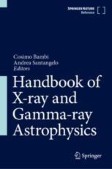Search
Search Results
-
Measuring Spacetime: From Big Bang to Black Holes
Space is not a boring static stage on which events unfold over time, but a dynamic entity with curvature, fluctuations and a rich life of its own...
-
X-Ray Detectors for Astrophysics
Astrophysical observations in the X-ray band require the detection of the photons in combination with an imaging system. This imaging system can vary...
-
Cd(Zn)Te Detectors for Hard X-Ray and Gamma-Ray Astronomy
The energy range of hard X-rays and gamma-rays is dominated by non-thermal emissions. Physical processes such as particle acceleration, accretion,...
-
The nearest neutron star candidate in a binary revealed by optical time-domain surveys
The near-Earth (within ∼100 pc) supernova explosions in the past several million years can cause the global deposition of radioactive elements (e.g., 60...
-
Close Binary Stars. IV: Applications of the Roche Model
AbstractThe article describes various ways of applying the Roche model to close binary systems. A review of the verification of the evolutionary...

-
Simultaneous X-ray/UV Observations of Ultraluminous X-ray Source Holmberg II X-1 with Indian Space Mission Astrosat
AbstractWe present the results of eight epochs of simultaneous UV and X-ray observations of the highly variable ultraluminous X-ray source (ULX)...

-
Gamma-Ray Bursts
Gamma-ray bursts (GRBs) are short and intense bursts of ∼100 keV−1 MeV photons, usually followed by long-lasting decaying afterglow emission in a...
-
Gravitational waves and electromagnetic transients
The advanced gravitational wave (GW) detector network has started routine detection of signals from merging compact binaries. Data indicate that in a...

-
X-ray Properties of the Luminous Quasar PG 1634+706 at \(z=1.337\) from SRG and XMM-Newton Data
AbstractIn the fall of 2019, during the in-flight calibration phase of the SRG observatory, the onboard eROSITA and Mikhail Pavlinsky ART-XC...

-
X-Ray Emission of Massive Stars and Their Winds
Most types of massive stars display X-ray emission that is strongly affected by the properties of their stellar winds. Single nonmagnetic OB stars...
-
Low-Mass and Sub-stellar Eclipsing Binaries in Stellar Clusters
We highlight the importance of eclipsing double-line binaries in our understanding on star formation and evolution. We review the recent discoveries...
-
Central Part of the Galaxy in X-Rays
AbstractStudying the central part of the Galaxy is of great interest for observational astronomy and astrophysics. Based on the results from...

-
A possible planet candidate in an external galaxy detected through X-ray transit
Many lines of reasoning suggest that external galaxies should host planetary systems, but detecting them by methods typically used in our own Galaxy...

-
X-Ray Astronomy
Although we use X-rays for penetrating scans of the human body, the Earth’s atmosphere is almost completely opaque to X-rays, and X-ray astronomy has...
-
In-Orbit Background for X-Ray Detectors
In-orbit background is an unavoidable feature of all spaceborne X-ray detectors and arises both from cosmic sources (diffuse or point-like) and from...
-
The Hot Interstellar Medium
The interstellar medium (ISM) of galaxies very often contains a gas component that reaches the temperature of several million degrees, whose physical...
-
Probing the Circumgalactic Medium with X-ray Absorption Lines
The circumgalactic medium (CGM) fills the dark matter halo of a galaxy, serving as a gas reservoir between the intergalactic medium and the stellar...
-
Ultraviolet Spectropolarimetry: on the origin of rapidly rotating B stars
UV spectroscopy and spectropolarimetry hold the key to understanding certain aspects of massive stars that are largely inaccessible (or exceptionally...

-
GRB-SN Association within the Binary-Driven Hypernova Model
AbstractLong gamma-ray bursts (GRBs), in a few seconds, release luminosities (in gamma-rays) comparable to the luminosity of all stars in the...

-
The Birth of a Relativistic Jet Following the Disruption of a Star by a Cosmological Black Hole
A black hole can launch a powerful relativistic jet after it tidally disrupts a star. If this jet fortuitously aligns with our line of sight, the...

